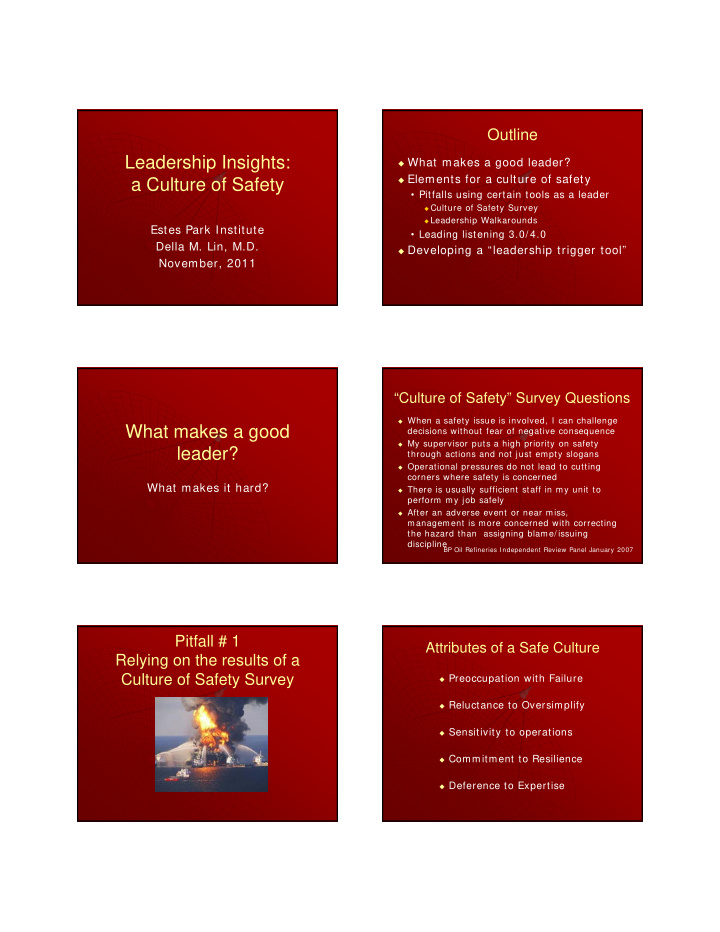



Outline Leadership Insights: What makes a good leader? Elements for a culture of safety a Culture of Safety • Pitfalls using certain tools as a leader Culture of Safety Survey Leadership Walkarounds Estes Park Institute • Leading listening 3.0/ 4.0 Della M. Lin, M.D. Developing a “leadership trigger tool” November, 2011 “Culture of Safety” Survey Questions When a safety issue is involved, I can challenge What makes a good decisions without fear of negative consequence My supervisor puts a high priority on safety leader? through actions and not just empty slogans Operational pressures do not lead to cutting corners where safety is concerned What makes it hard? There is usually sufficient staff in my unit to perform my job safely After an adverse event or near miss, management is more concerned with correcting the hazard than assigning blame/ issuing discipline BP Oil Refineries Independent Review Panel January 2007 Pitfall # 1 Attributes of a Safe Culture Relying on the results of a Culture of Safety Survey Preoccupation with Failure Reluctance to Oversimplify Sensitivity to operations Commitment to Resilience Deference to Expertise
Attributes of a Safe Culture Churchill Audit Preoccupation with Failure “ I ought to have known, My advisors ought to have known, Reluctance to Oversimplify I ought to have been told, I ought to have asked” Sensitivity to operations Why didn’t I know? Commitment to Resilience Why didn’t my advisors know? Why wasn’t I told? Deference to Expertise Why didn’t I ask? Improvement in Danger in oversimplification: Short term Outcome in Heart Failure Patients “measuring” patient safety… 7 million patients Mean age 80 Sensitivity Specificity 52% HTN, 38% DM, 37% COPD Voluntary Reporting 0% 100% LOS dropped from 8.8 to 6.3 days AHRQ Patient Safety 8.5% 98.5% Indicators (PSI) Hospital mortality dropped: 8.5 to 4.3 % Utah/ Missouri 46.6% 90.2% 30 day mortality dropped: 12.8 to 10.7% Adverse Event Classification IHI Global Trigger 94.9% 100% Tool 30 day readmission increased: 17.1-20.1% Post-discharge mortality increased: 4.3-6.4% Discharges to SNF increased 13-20% Classen,D et. Al. Health Affairs, April 2011, 30: 4, pp. 581-589 JAMA 2010 303 (21): 2141-7 Attributes of a Safe Culture What is our Problem-Solving Culture ? Preoccupation with Failure Leader Responsiveness Reluctance to Oversimplify Cynical Culture I m provem ent Culture Squeaky Wheel Embrace Wisdom “Club Culture” Resilience Sensitivity to operations Satisficing Culture Problem Patching Culture Commitment to Resilience “Good Enough” Workarounds Heroes Burnout First needle in a haystack Deference to Expertise COST of the PROBLEM
Attributes of a Safe Culture Pitfall #2 Prescriptive Leadership Preoccupation with Failure Walkarounds Reluctance to Oversimplify Sensitivity to operations Commitment to Resilience Deference to Expertise Tension of Attributes of a Safe Culture Execution and Learning Culture Preoccupation with Failure • Focus on • Focus on deliverables improvement • Make the • Break past the Reluctance to Oversimplify numbers numbers • Remove the • Improve the low performers low performers • Fix what is Sensitivity to operations Execution Learning broken • Diagnose why Culture Culture • Listen to the errors occur customer Commitment to Resilience • Learn from the • Execute customer against the • Monitor and plan Deference to Expertise evolve the plan Level 1.0 : Downloading Level 2.0: Debate Otto Sharmer: Theory U Otto Sharmer: Theory U
Level 4.0 Level 3.0: Dialog Generative Creativity Otto Sharmer: Theory U Otto Sharmer: Theory U If you were Churchill, what would you want to know every day? Leadership Trigger Tool?
Recommend
More recommend